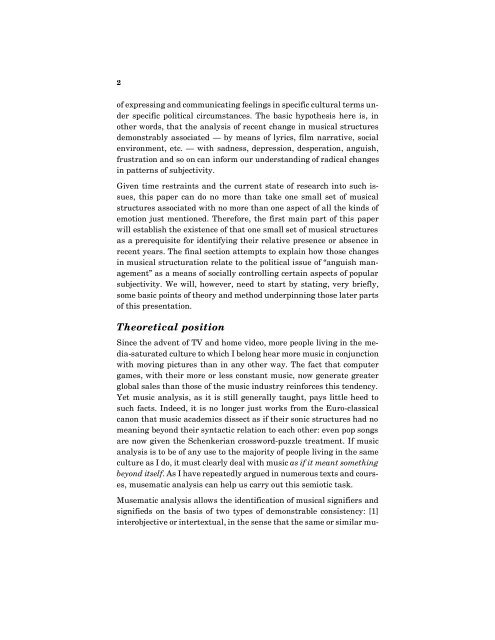You also want an ePaper? Increase the reach of your titles
YUMPU automatically turns print PDFs into web optimized ePapers that Google loves.
2<br />
of expressing and communicating feelings in specific cultural terms under<br />
specific political circumstances. The basic hypothesis here is, in<br />
other words, that the analysis of recent change in musical structures<br />
demonstrably associated — by means of lyrics, film narrative, social<br />
environment, etc. — with sadness, depression, desperation, anguish,<br />
frustration and so on can inform our understanding of radical changes<br />
in patterns of subjectivity.<br />
Given time restraints and the current state of research into such issues,<br />
this paper can do no more than take one small set of musical<br />
structures associated with no more than one aspect of all the kinds of<br />
emotion just mentioned. Therefore, the first main part of this paper<br />
will establish the existence of that one small set of musical structures<br />
as a prerequisite for identifying their relative presence or absence in<br />
recent years. The final section attempts to explain how those changes<br />
in musical structuration relate to the political issue of “anguish management”<br />
as a means of socially controlling certain aspects of popular<br />
subjectivity. We will, however, need to start by stating, very briefly,<br />
some basic points of theory and method underpinning those later parts<br />
of this presentation.<br />
Theoretical position<br />
Since the advent of TV and home video, more people living in the media-saturated<br />
culture to which I belong hear more music in conjunction<br />
with moving pictures than in any other way. The fact that computer<br />
games, with their more or less constant music, now generate greater<br />
global sales than those of the music industry reinforces this tendency.<br />
Yet music analysis, as it is still generally taught, pays little heed to<br />
such facts. Indeed, it is no longer just works from the Euro-classical<br />
canon that music academics dissect as if their sonic structures had no<br />
meaning beyond their syntactic relation to each other: even pop songs<br />
are now given the Schenkerian crossword-puzzle treatment. If music<br />
analysis is to be of any use to the majority of people living in the same<br />
culture as I do, it must clearly deal with music as if it meant something<br />
beyond itself. As I have repeatedly argued in numerous texts and courses,<br />
musematic analysis can help us carry out this semiotic task.<br />
Musematic analysis allows the identification of musical signifiers and<br />
signifieds on the basis of two types of demonstrable consistency: [1]<br />
interobjective or intertextual, in the sense that the same or similar mu-














